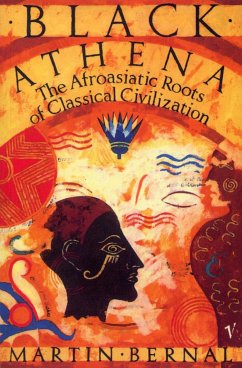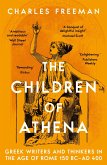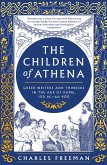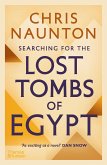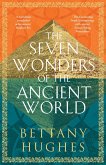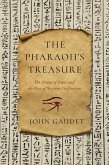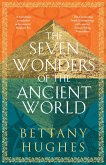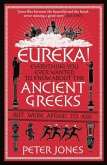Martin Bernal
Black Athena
The Afroasiatic Roots of Classical Civilization Volume One:The Fabrication of Ancient Greece 1785-1985
18,99 €
inkl. MwSt.
Sofort lieferbar

9 °P sammeln
Martin Bernal
Black Athena
The Afroasiatic Roots of Classical Civilization Volume One:The Fabrication of Ancient Greece 1785-1985
- Broschiertes Buch
- Merkliste
- Auf die Merkliste
- Bewerten Bewerten
- Teilen
- Produkt teilen
- Produkterinnerung
- Produkterinnerung
- Weitere 11 Ausgaben:
- Gebundenes Buch
- Gebundenes Buch
- Gebundenes Buch
- Broschiertes Buch
- eBook, ePUB
- eBook, ePUB
- eBook, ePUB
- eBook, ePUB
- eBook, PDF
- eBook, PDF
- eBook, PDF
A challenge to the whole basis of thinking on the subject of classical civilization. The author argues that it has its roots in Afroasiatic cultures, and that these influences have been systematically ignored, suppressed or denied since the 18th century.
Andere Kunden interessierten sich auch für
![The Children of Athena The Children of Athena]() Charles FreemanThe Children of Athena10,99 €
Charles FreemanThe Children of Athena10,99 €![The Children of Athena The Children of Athena]() Charles FreemanThe Children of Athena33,99 €
Charles FreemanThe Children of Athena33,99 €![Searching for the Lost Tombs of Egypt Searching for the Lost Tombs of Egypt]() Chris NauntonSearching for the Lost Tombs of Egypt16,99 €
Chris NauntonSearching for the Lost Tombs of Egypt16,99 €![The Seven Wonders of the Ancient World The Seven Wonders of the Ancient World]() Bettany HughesThe Seven Wonders of the Ancient World14,99 €
Bettany HughesThe Seven Wonders of the Ancient World14,99 €![The Pharaoh's Treasure The Pharaoh's Treasure]() John GaudetThe Pharaoh's Treasure25,99 €
John GaudetThe Pharaoh's Treasure25,99 €![The Seven Wonders of the Ancient World The Seven Wonders of the Ancient World]() Bettany HughesThe Seven Wonders of the Ancient World28,99 €
Bettany HughesThe Seven Wonders of the Ancient World28,99 €![Eureka! Eureka!]() Peter Jones (Author)Eureka!14,99 €
Peter Jones (Author)Eureka!14,99 €-
-
-
A challenge to the whole basis of thinking on the subject of classical civilization. The author argues that it has its roots in Afroasiatic cultures, and that these influences have been systematically ignored, suppressed or denied since the 18th century.
Hinweis: Dieser Artikel kann nur an eine deutsche Lieferadresse ausgeliefert werden.
Hinweis: Dieser Artikel kann nur an eine deutsche Lieferadresse ausgeliefert werden.
Produktdetails
- Produktdetails
- Verlag: Vintage Publishing
- Seitenzahl: 608
- Erscheinungstermin: 21. November 1991
- Englisch
- Abmessung: 199mm x 131mm x 60mm
- Gewicht: 426g
- ISBN-13: 9780099887805
- ISBN-10: 0099887800
- Artikelnr.: 21886689
- Herstellerkennzeichnung
- Libri GmbH
- Europaallee 1
- 36244 Bad Hersfeld
- 06621 890
- Verlag: Vintage Publishing
- Seitenzahl: 608
- Erscheinungstermin: 21. November 1991
- Englisch
- Abmessung: 199mm x 131mm x 60mm
- Gewicht: 426g
- ISBN-13: 9780099887805
- ISBN-10: 0099887800
- Artikelnr.: 21886689
- Herstellerkennzeichnung
- Libri GmbH
- Europaallee 1
- 36244 Bad Hersfeld
- 06621 890
Martin Bernal
\Preface and Acknowledgements Transcription and Phonetics Chronological Tables Introduction Intrinsic reasons for preferring the Revised Ancient Model to the Aryan one Some theoretical considerations A summary of the argument Chapter I Crete before the palaces, 7000–2100 bc The ‘diffusionist’ and ‘isolationist’ debate Crete before the 21st century bc Cretan religion in the Early Bronze Age Conclusion Chapter II Egypt’s influence on Boiotia and the peloponnese in the 3rd millennium, I The cultic, mythical and legendary evidence Semel
and Alkm
n
Athena and Athens in Boiotia: The cults of Athena It
nia and Athena Alalkomena N
it, the controller of water The battles between N
it and Seth, Athena and Poseidon Poseidon / Seth N
it / Athena and Nephthys / Erinys Herakles Conclusion Chapter III Egypt’s influence on Boiotia and the peloponnese in the 3rd millennium, II The archaeological evidence Spartan archaeology: the tomb of Alkm
n
The tomb of Amphion and Z
thos The draining of the Kopais Granaries Irrigation and settlement in the Argolid Drainage and irrigation in Arkadia Parallels between Boiotian and Arkadian place names Social and political structures in Early Helladic Greece Other archaeological traces of Old Kingdom Egypt in the Aegean The end of Early Bronze Age ‘high’ civilization Conclusion Chapter IV The Old Palace Period in Crete and the Egyptian Middle Kingdom, 2100 to 1730 bc Early Minoan III – the Prepalatial Period Lead and spirals The Cretan palaces Crètan writing systems Cultic symbols in Early Palatial Crete Possible Anatolian origins of the bull cult Thunder and sex: Min, Pan and Bwäzä Min and Minos The case against Egyptian influence Mont and Rhadamanthys The survival of the bull cult — Cretan conservatism Conclusion Chapter V Ses
stris, I The archaeological and documentary evidence for the Greek accounts of his conquest The discovery of the Mit Rahina inscription The significance of the inscription as evidence for an Egyptian empire in Asia during the Middle Kingdom Senwosre and Ses
stris The real and the fantastic in the Ses
stris stories Middle Kingdom Egypt’s military capability The background Archaeological evidence for the campaigns Was Ses
stris the destroyer? Ses
stris in Thrace and Scythia? Ses
stris in Colchis? The evidence for Ses
stris’ ‘conquests’ from the Mit Rahina inscription Conclusion Chapter VI Ses
stris, II The cultic, mythical and legendary evidence The Egyptian tradition The traditions of the Levant and Anatolia Thrace and Scythia Colchis: an Egyptian colony? Mesopotamia and Iran The Greek legends of Memn
n and his conquests of Anatolia The case for an Egyptian conquest of Troy c. 1900 bc Ses
stris / Senwosre and Amenem
’s conquests: a summary of the evidence Chapter VII The Thera eruption: from the Aegean to China The controversy over dating The eruption re-dated The implications of the re-dating Thera and Kalliste Volcanic allusions in the Exodus story Membliaros and the pall of darkness The myth of Atlantis The Hekla eruption in Iceland China: the historiographical impact The world-wide impact of the Thera eruption Conclusion Chapter VIII The Hyksos The chronology of the 13th Dynasty: chaos in Egypt The chronology of the 15th Dynasty: the beginnings of Hyksos rule The Hyksos capital at Tell el Daba’a The 400-year stela and the Temple of Seth A chronological summary Who were the Hyksos? Different views on the origin and the arrival of the Hyksos The Hyksos as a multinational corporation Horses and chariots: Hurrians and Aryans Hurrians and Hyksos Hyksos material culture The Hyksos and the biblical captivity or sojourn in Egypt Conclusion Chapter IX Crete, Thera and the birth of Mycenaean culture in the i8th and 17th centuries bc A Hyksos invasion? The Cretan new palaces The weapons of Crete in MMIII The flying gallop, the sphinx and the griffin Was there a Hyksos invasion of Crete c. 1730 bc? The Hyksos in Thera? The origins of Mycenaean civilization The Aryanist Model of invasion Between Aryan and Ancient: Frank Stubbings Conclusion: a revision of the Ancient Model Chapter X Egyptian, Mesopotamian and Levantine contacts with the Aegean The documentary evidence Egyptian place names referring to the Aegean The etymology of Danaan Documentary evidence for Egyptian relations with the Aegean in the Late Bronze Age Accuracy and hybridism in Egyptian inscriptions and tomb paintings Why did Cretan princes bring tribute to Egypt? Dating the Mycenaean domination of Crete Crete and Mycenaean missions to Egypt The statue base of Amen
phis III Contacts between Egypt and the Aegean in the late 18th and 19th Dynasties A summary of the evidence from Egyptian documents and paintings Mesopotamian and Ugaritic documents Aegean documents Conclusion Chapter XI Egyptian and Levantine contacts with the Aegean, 1550–1250 bc The archaeological evidence Late Mycenaean Greece The relative isolation of the Aegean 1550–1470 bc Egyptian expansion from c. 1520 to 1420 Pelops and the Achaians: evidence from Anatolia Pelops ‘the crown prince’? The Achaians and the Danaans Archaeological traces of the Achaians Mycenaeans and Hittites Ugarit and Cyprus Mycenaean expansion and the conquests of Tuthm
sis III The merchants of the Mediterranean in the Late Bronze Age? The Kä shipwreck: the sailors The Egyptian Thebes and Mycenae, 1420–1370 bc The foundation deposit plaques The vocabulary of trade The decline of Egyptian influence on the Aegean 1370–1220 bc Phi and Psi figurines and smiting gods Canaanite jars Ivory Conclusion Chapter XII The heroic end to the heroic age The fall of Thebes, Troy and Mycenae 1250–1150 bc Cylinder seals The Boiotian Thebes and the Phoenicians’ arrival Ancient chronographies Kadmos and the alphabet Kadmos and Danaos: Hyksos rulers Problems in the writing of Linear B The treasure of the Kadmeion The Kassite connection The destruction of Thebes A brief survey of Trojan history The date of the Trojan War Thebes and Troy The collapse of Mycenaean civilization Conclusion Conclusion Maps and Charts Notes Glossary Bibliography Index
and Alkm
n
Athena and Athens in Boiotia: The cults of Athena It
nia and Athena Alalkomena N
it, the controller of water The battles between N
it and Seth, Athena and Poseidon Poseidon / Seth N
it / Athena and Nephthys / Erinys Herakles Conclusion Chapter III Egypt’s influence on Boiotia and the peloponnese in the 3rd millennium, II The archaeological evidence Spartan archaeology: the tomb of Alkm
n
The tomb of Amphion and Z
thos The draining of the Kopais Granaries Irrigation and settlement in the Argolid Drainage and irrigation in Arkadia Parallels between Boiotian and Arkadian place names Social and political structures in Early Helladic Greece Other archaeological traces of Old Kingdom Egypt in the Aegean The end of Early Bronze Age ‘high’ civilization Conclusion Chapter IV The Old Palace Period in Crete and the Egyptian Middle Kingdom, 2100 to 1730 bc Early Minoan III – the Prepalatial Period Lead and spirals The Cretan palaces Crètan writing systems Cultic symbols in Early Palatial Crete Possible Anatolian origins of the bull cult Thunder and sex: Min, Pan and Bwäzä Min and Minos The case against Egyptian influence Mont and Rhadamanthys The survival of the bull cult — Cretan conservatism Conclusion Chapter V Ses
stris, I The archaeological and documentary evidence for the Greek accounts of his conquest The discovery of the Mit Rahina inscription The significance of the inscription as evidence for an Egyptian empire in Asia during the Middle Kingdom Senwosre and Ses
stris The real and the fantastic in the Ses
stris stories Middle Kingdom Egypt’s military capability The background Archaeological evidence for the campaigns Was Ses
stris the destroyer? Ses
stris in Thrace and Scythia? Ses
stris in Colchis? The evidence for Ses
stris’ ‘conquests’ from the Mit Rahina inscription Conclusion Chapter VI Ses
stris, II The cultic, mythical and legendary evidence The Egyptian tradition The traditions of the Levant and Anatolia Thrace and Scythia Colchis: an Egyptian colony? Mesopotamia and Iran The Greek legends of Memn
n and his conquests of Anatolia The case for an Egyptian conquest of Troy c. 1900 bc Ses
stris / Senwosre and Amenem
’s conquests: a summary of the evidence Chapter VII The Thera eruption: from the Aegean to China The controversy over dating The eruption re-dated The implications of the re-dating Thera and Kalliste Volcanic allusions in the Exodus story Membliaros and the pall of darkness The myth of Atlantis The Hekla eruption in Iceland China: the historiographical impact The world-wide impact of the Thera eruption Conclusion Chapter VIII The Hyksos The chronology of the 13th Dynasty: chaos in Egypt The chronology of the 15th Dynasty: the beginnings of Hyksos rule The Hyksos capital at Tell el Daba’a The 400-year stela and the Temple of Seth A chronological summary Who were the Hyksos? Different views on the origin and the arrival of the Hyksos The Hyksos as a multinational corporation Horses and chariots: Hurrians and Aryans Hurrians and Hyksos Hyksos material culture The Hyksos and the biblical captivity or sojourn in Egypt Conclusion Chapter IX Crete, Thera and the birth of Mycenaean culture in the i8th and 17th centuries bc A Hyksos invasion? The Cretan new palaces The weapons of Crete in MMIII The flying gallop, the sphinx and the griffin Was there a Hyksos invasion of Crete c. 1730 bc? The Hyksos in Thera? The origins of Mycenaean civilization The Aryanist Model of invasion Between Aryan and Ancient: Frank Stubbings Conclusion: a revision of the Ancient Model Chapter X Egyptian, Mesopotamian and Levantine contacts with the Aegean The documentary evidence Egyptian place names referring to the Aegean The etymology of Danaan Documentary evidence for Egyptian relations with the Aegean in the Late Bronze Age Accuracy and hybridism in Egyptian inscriptions and tomb paintings Why did Cretan princes bring tribute to Egypt? Dating the Mycenaean domination of Crete Crete and Mycenaean missions to Egypt The statue base of Amen
phis III Contacts between Egypt and the Aegean in the late 18th and 19th Dynasties A summary of the evidence from Egyptian documents and paintings Mesopotamian and Ugaritic documents Aegean documents Conclusion Chapter XI Egyptian and Levantine contacts with the Aegean, 1550–1250 bc The archaeological evidence Late Mycenaean Greece The relative isolation of the Aegean 1550–1470 bc Egyptian expansion from c. 1520 to 1420 Pelops and the Achaians: evidence from Anatolia Pelops ‘the crown prince’? The Achaians and the Danaans Archaeological traces of the Achaians Mycenaeans and Hittites Ugarit and Cyprus Mycenaean expansion and the conquests of Tuthm
sis III The merchants of the Mediterranean in the Late Bronze Age? The Kä shipwreck: the sailors The Egyptian Thebes and Mycenae, 1420–1370 bc The foundation deposit plaques The vocabulary of trade The decline of Egyptian influence on the Aegean 1370–1220 bc Phi and Psi figurines and smiting gods Canaanite jars Ivory Conclusion Chapter XII The heroic end to the heroic age The fall of Thebes, Troy and Mycenae 1250–1150 bc Cylinder seals The Boiotian Thebes and the Phoenicians’ arrival Ancient chronographies Kadmos and the alphabet Kadmos and Danaos: Hyksos rulers Problems in the writing of Linear B The treasure of the Kadmeion The Kassite connection The destruction of Thebes A brief survey of Trojan history The date of the Trojan War Thebes and Troy The collapse of Mycenaean civilization Conclusion Conclusion Maps and Charts Notes Glossary Bibliography Index
\Preface and Acknowledgements Transcription and Phonetics Chronological Tables Introduction Intrinsic reasons for preferring the Revised Ancient Model to the Aryan one Some theoretical considerations A summary of the argument Chapter I Crete before the palaces, 7000–2100 bc The ‘diffusionist’ and ‘isolationist’ debate Crete before the 21st century bc Cretan religion in the Early Bronze Age Conclusion Chapter II Egypt’s influence on Boiotia and the peloponnese in the 3rd millennium, I The cultic, mythical and legendary evidence Semel
and Alkm
n
Athena and Athens in Boiotia: The cults of Athena It
nia and Athena Alalkomena N
it, the controller of water The battles between N
it and Seth, Athena and Poseidon Poseidon / Seth N
it / Athena and Nephthys / Erinys Herakles Conclusion Chapter III Egypt’s influence on Boiotia and the peloponnese in the 3rd millennium, II The archaeological evidence Spartan archaeology: the tomb of Alkm
n
The tomb of Amphion and Z
thos The draining of the Kopais Granaries Irrigation and settlement in the Argolid Drainage and irrigation in Arkadia Parallels between Boiotian and Arkadian place names Social and political structures in Early Helladic Greece Other archaeological traces of Old Kingdom Egypt in the Aegean The end of Early Bronze Age ‘high’ civilization Conclusion Chapter IV The Old Palace Period in Crete and the Egyptian Middle Kingdom, 2100 to 1730 bc Early Minoan III – the Prepalatial Period Lead and spirals The Cretan palaces Crètan writing systems Cultic symbols in Early Palatial Crete Possible Anatolian origins of the bull cult Thunder and sex: Min, Pan and Bwäzä Min and Minos The case against Egyptian influence Mont and Rhadamanthys The survival of the bull cult — Cretan conservatism Conclusion Chapter V Ses
stris, I The archaeological and documentary evidence for the Greek accounts of his conquest The discovery of the Mit Rahina inscription The significance of the inscription as evidence for an Egyptian empire in Asia during the Middle Kingdom Senwosre and Ses
stris The real and the fantastic in the Ses
stris stories Middle Kingdom Egypt’s military capability The background Archaeological evidence for the campaigns Was Ses
stris the destroyer? Ses
stris in Thrace and Scythia? Ses
stris in Colchis? The evidence for Ses
stris’ ‘conquests’ from the Mit Rahina inscription Conclusion Chapter VI Ses
stris, II The cultic, mythical and legendary evidence The Egyptian tradition The traditions of the Levant and Anatolia Thrace and Scythia Colchis: an Egyptian colony? Mesopotamia and Iran The Greek legends of Memn
n and his conquests of Anatolia The case for an Egyptian conquest of Troy c. 1900 bc Ses
stris / Senwosre and Amenem
’s conquests: a summary of the evidence Chapter VII The Thera eruption: from the Aegean to China The controversy over dating The eruption re-dated The implications of the re-dating Thera and Kalliste Volcanic allusions in the Exodus story Membliaros and the pall of darkness The myth of Atlantis The Hekla eruption in Iceland China: the historiographical impact The world-wide impact of the Thera eruption Conclusion Chapter VIII The Hyksos The chronology of the 13th Dynasty: chaos in Egypt The chronology of the 15th Dynasty: the beginnings of Hyksos rule The Hyksos capital at Tell el Daba’a The 400-year stela and the Temple of Seth A chronological summary Who were the Hyksos? Different views on the origin and the arrival of the Hyksos The Hyksos as a multinational corporation Horses and chariots: Hurrians and Aryans Hurrians and Hyksos Hyksos material culture The Hyksos and the biblical captivity or sojourn in Egypt Conclusion Chapter IX Crete, Thera and the birth of Mycenaean culture in the i8th and 17th centuries bc A Hyksos invasion? The Cretan new palaces The weapons of Crete in MMIII The flying gallop, the sphinx and the griffin Was there a Hyksos invasion of Crete c. 1730 bc? The Hyksos in Thera? The origins of Mycenaean civilization The Aryanist Model of invasion Between Aryan and Ancient: Frank Stubbings Conclusion: a revision of the Ancient Model Chapter X Egyptian, Mesopotamian and Levantine contacts with the Aegean The documentary evidence Egyptian place names referring to the Aegean The etymology of Danaan Documentary evidence for Egyptian relations with the Aegean in the Late Bronze Age Accuracy and hybridism in Egyptian inscriptions and tomb paintings Why did Cretan princes bring tribute to Egypt? Dating the Mycenaean domination of Crete Crete and Mycenaean missions to Egypt The statue base of Amen
phis III Contacts between Egypt and the Aegean in the late 18th and 19th Dynasties A summary of the evidence from Egyptian documents and paintings Mesopotamian and Ugaritic documents Aegean documents Conclusion Chapter XI Egyptian and Levantine contacts with the Aegean, 1550–1250 bc The archaeological evidence Late Mycenaean Greece The relative isolation of the Aegean 1550–1470 bc Egyptian expansion from c. 1520 to 1420 Pelops and the Achaians: evidence from Anatolia Pelops ‘the crown prince’? The Achaians and the Danaans Archaeological traces of the Achaians Mycenaeans and Hittites Ugarit and Cyprus Mycenaean expansion and the conquests of Tuthm
sis III The merchants of the Mediterranean in the Late Bronze Age? The Kä shipwreck: the sailors The Egyptian Thebes and Mycenae, 1420–1370 bc The foundation deposit plaques The vocabulary of trade The decline of Egyptian influence on the Aegean 1370–1220 bc Phi and Psi figurines and smiting gods Canaanite jars Ivory Conclusion Chapter XII The heroic end to the heroic age The fall of Thebes, Troy and Mycenae 1250–1150 bc Cylinder seals The Boiotian Thebes and the Phoenicians’ arrival Ancient chronographies Kadmos and the alphabet Kadmos and Danaos: Hyksos rulers Problems in the writing of Linear B The treasure of the Kadmeion The Kassite connection The destruction of Thebes A brief survey of Trojan history The date of the Trojan War Thebes and Troy The collapse of Mycenaean civilization Conclusion Conclusion Maps and Charts Notes Glossary Bibliography Index
and Alkm
n
Athena and Athens in Boiotia: The cults of Athena It
nia and Athena Alalkomena N
it, the controller of water The battles between N
it and Seth, Athena and Poseidon Poseidon / Seth N
it / Athena and Nephthys / Erinys Herakles Conclusion Chapter III Egypt’s influence on Boiotia and the peloponnese in the 3rd millennium, II The archaeological evidence Spartan archaeology: the tomb of Alkm
n
The tomb of Amphion and Z
thos The draining of the Kopais Granaries Irrigation and settlement in the Argolid Drainage and irrigation in Arkadia Parallels between Boiotian and Arkadian place names Social and political structures in Early Helladic Greece Other archaeological traces of Old Kingdom Egypt in the Aegean The end of Early Bronze Age ‘high’ civilization Conclusion Chapter IV The Old Palace Period in Crete and the Egyptian Middle Kingdom, 2100 to 1730 bc Early Minoan III – the Prepalatial Period Lead and spirals The Cretan palaces Crètan writing systems Cultic symbols in Early Palatial Crete Possible Anatolian origins of the bull cult Thunder and sex: Min, Pan and Bwäzä Min and Minos The case against Egyptian influence Mont and Rhadamanthys The survival of the bull cult — Cretan conservatism Conclusion Chapter V Ses
stris, I The archaeological and documentary evidence for the Greek accounts of his conquest The discovery of the Mit Rahina inscription The significance of the inscription as evidence for an Egyptian empire in Asia during the Middle Kingdom Senwosre and Ses
stris The real and the fantastic in the Ses
stris stories Middle Kingdom Egypt’s military capability The background Archaeological evidence for the campaigns Was Ses
stris the destroyer? Ses
stris in Thrace and Scythia? Ses
stris in Colchis? The evidence for Ses
stris’ ‘conquests’ from the Mit Rahina inscription Conclusion Chapter VI Ses
stris, II The cultic, mythical and legendary evidence The Egyptian tradition The traditions of the Levant and Anatolia Thrace and Scythia Colchis: an Egyptian colony? Mesopotamia and Iran The Greek legends of Memn
n and his conquests of Anatolia The case for an Egyptian conquest of Troy c. 1900 bc Ses
stris / Senwosre and Amenem
’s conquests: a summary of the evidence Chapter VII The Thera eruption: from the Aegean to China The controversy over dating The eruption re-dated The implications of the re-dating Thera and Kalliste Volcanic allusions in the Exodus story Membliaros and the pall of darkness The myth of Atlantis The Hekla eruption in Iceland China: the historiographical impact The world-wide impact of the Thera eruption Conclusion Chapter VIII The Hyksos The chronology of the 13th Dynasty: chaos in Egypt The chronology of the 15th Dynasty: the beginnings of Hyksos rule The Hyksos capital at Tell el Daba’a The 400-year stela and the Temple of Seth A chronological summary Who were the Hyksos? Different views on the origin and the arrival of the Hyksos The Hyksos as a multinational corporation Horses and chariots: Hurrians and Aryans Hurrians and Hyksos Hyksos material culture The Hyksos and the biblical captivity or sojourn in Egypt Conclusion Chapter IX Crete, Thera and the birth of Mycenaean culture in the i8th and 17th centuries bc A Hyksos invasion? The Cretan new palaces The weapons of Crete in MMIII The flying gallop, the sphinx and the griffin Was there a Hyksos invasion of Crete c. 1730 bc? The Hyksos in Thera? The origins of Mycenaean civilization The Aryanist Model of invasion Between Aryan and Ancient: Frank Stubbings Conclusion: a revision of the Ancient Model Chapter X Egyptian, Mesopotamian and Levantine contacts with the Aegean The documentary evidence Egyptian place names referring to the Aegean The etymology of Danaan Documentary evidence for Egyptian relations with the Aegean in the Late Bronze Age Accuracy and hybridism in Egyptian inscriptions and tomb paintings Why did Cretan princes bring tribute to Egypt? Dating the Mycenaean domination of Crete Crete and Mycenaean missions to Egypt The statue base of Amen
phis III Contacts between Egypt and the Aegean in the late 18th and 19th Dynasties A summary of the evidence from Egyptian documents and paintings Mesopotamian and Ugaritic documents Aegean documents Conclusion Chapter XI Egyptian and Levantine contacts with the Aegean, 1550–1250 bc The archaeological evidence Late Mycenaean Greece The relative isolation of the Aegean 1550–1470 bc Egyptian expansion from c. 1520 to 1420 Pelops and the Achaians: evidence from Anatolia Pelops ‘the crown prince’? The Achaians and the Danaans Archaeological traces of the Achaians Mycenaeans and Hittites Ugarit and Cyprus Mycenaean expansion and the conquests of Tuthm
sis III The merchants of the Mediterranean in the Late Bronze Age? The Kä shipwreck: the sailors The Egyptian Thebes and Mycenae, 1420–1370 bc The foundation deposit plaques The vocabulary of trade The decline of Egyptian influence on the Aegean 1370–1220 bc Phi and Psi figurines and smiting gods Canaanite jars Ivory Conclusion Chapter XII The heroic end to the heroic age The fall of Thebes, Troy and Mycenae 1250–1150 bc Cylinder seals The Boiotian Thebes and the Phoenicians’ arrival Ancient chronographies Kadmos and the alphabet Kadmos and Danaos: Hyksos rulers Problems in the writing of Linear B The treasure of the Kadmeion The Kassite connection The destruction of Thebes A brief survey of Trojan history The date of the Trojan War Thebes and Troy The collapse of Mycenaean civilization Conclusion Conclusion Maps and Charts Notes Glossary Bibliography Index
